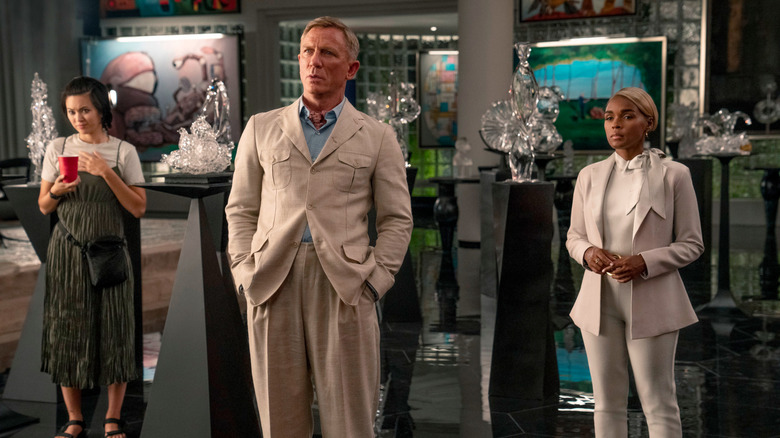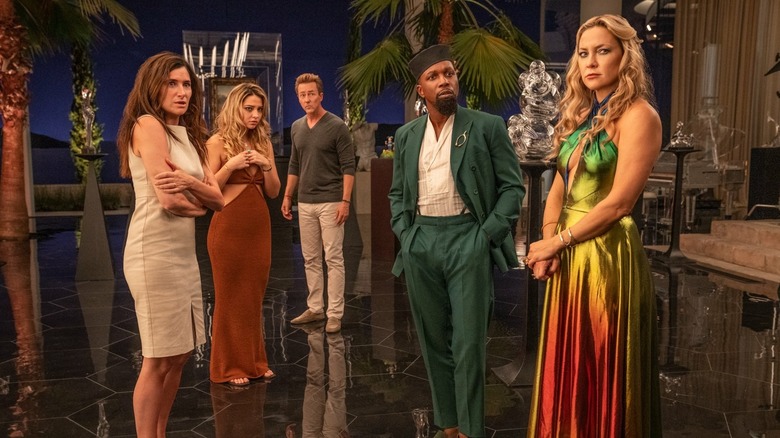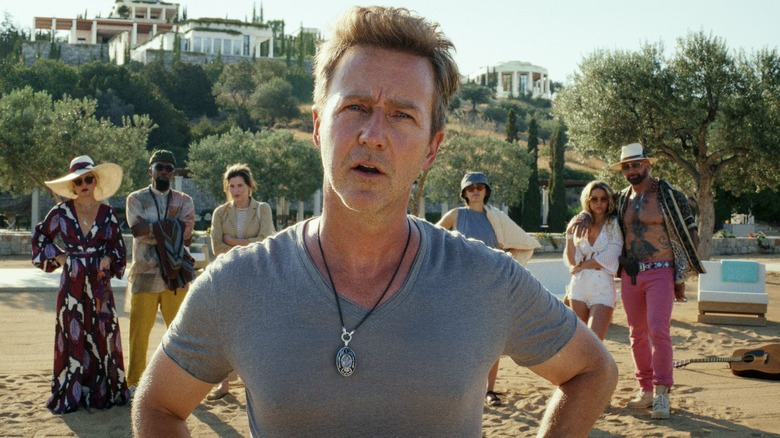The Glass Onion Atrium Needed To Be 'Slightly Tacky' On Purpose
Rian Johnson's latest whodunnit "Glass Onion: A Knives Out Mystery" is another fun mystery adventure from the filmmaker, filled with betrayal and pompous rich folks. Johnson once again points his knife at the upper class in the fast-paced thriller, combining his penchant for creating twists and turns with increasingly relevant sociopolitical themes. The film primarily takes place in the home of Miles Bron (Edward Norton), a billionaire pseudointellectual that brings his rich friends together for an extravagant, mystery-filled getaway. "Glass Onion" introduces a location designed to house the actions of its visitors and visually represent the pretentious nature of its owner.
A good mystery is often only as good as its environment. After all, it is no mistake that the title of Johnson's "Knives Out" follow-up directly alludes to the primary locale. Covered in glass and filled with a seemingly random assortment of artifacts and art pieces, the Glass Onion had to resemble a place that a person like Miles Bron would create. Unsurprisingly, designing the atrium for "Glass Onion" was an extensive endeavor, requiring several different sets to complete it. Most importantly, it had to have just the right amount of tackiness.
'Wanted it to feel slightly tacky'
In an interview with Variety, Johnson discussed the creation of the titular Glass Onion, which was always meant to feel sporadic:
"The atrium space is basically three sets in one. With each of three big setpieces, we move to a different space: the vibrant red of the seating area, the austere black and crystal of the Mona Lisa space, and then the bizarro Greek-ruins section where the dining table is. [Rick Heinrichs] wanted it to feel slightly tacky because they don't belong together but also to merge together, so your eyes don't throw up. It's kind of extraordinary what he did."
Despite the fact that the house in "Glass Onion" is quite beautiful from the outside, the interior is less alluring. As Johnson noted, the shockingly out-of-place, tacky additions to the home are organized in a way that doesn't throw us off too much. However, putting the actual Mona Lisa in a room along with an assortment of random art pieces, and a cart filled with Jared Leto's hard kombucha, speaks to Miles Bron's lack of taste and originality.
A place fit for a buffoon
As the name suggests, the Glass Onion is a see-through dome that sits at the center of the mansion. The atrium houses Miles Bron's art collection and fascination for other "disruptors" of the world. For instance, a poorly-painted mural of Kanye West can be seen in the background throughout the film (yikes!). The ego-driven, untalented billionaire sees himself among the most recognizable names in culture. But for all the money he spent on the Glass Onion, he still could not organize it in a manner that made any stylistic sense. Miles Bron is meant to be tacky as hell, and no amount of wealth can make him otherwise.
Miles Bron may not be based on a specific person, but it's hard to separate him and the Glass Onion from reality. Even though Johnson himself recognized any resemblance to a certain real-life billionaire was simply accidental, it's clear that Miles Bron is an archetypal representation of the wealthy, self-proclaimed "disruptors" present in our world. No one he surrounds himself with has the heart to tell him how much his ideas suck because they all benefit from his wealth. The ending of the film is that cathartic in the regard, at least.
"Glass Onion: A Knives Out Mystery" is available to stream on Netflix.


